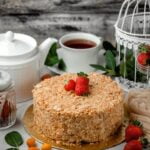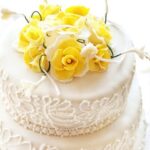Cake decorating is an immensely popular art form that allows individuals to unleash their creative side while creating delicious and visually stunning desserts. Whether you’re brand new to cake decorating or just looking for some inspiration, this article will guide you through the basics of decorating cakes for beginners. From essential tools and supplies to step-by-step instructions and troubleshooting tips, you’ll find everything you need to start your cake decorating journey.
Decorating cakes can be a fun and rewarding hobby for beginners. Not only does it allow you to express your creativity, but it also provides an opportunity to explore different techniques and experiment with flavors and designs. The possibilities are endless when it comes to cake decorating, making it a highly versatile and customizable art form.
In this article, we will cover the essential tools and supplies needed for cake decorating, as well as provide step-by-step instructions on how to prepare your cake for decorating like a pro. We’ll also explore fundamental techniques such as piping, rosettes, and borders that every beginner should learn.
Additionally, we’ll dive into working with fondant, selecting the right colors and flavors, troubleshooting common mistakes, adding the wow factor to your creations, and showcasing your beautifully decorated cakes.
By the end of this article, you will have gained valuable knowledge and a solid foundation in cake decorating. So grab your apron and get ready to embark on an exciting journey filled with delicious creations.
Essential Tools and Supplies for Cake Decorating
When it comes to cake decorating, having the right tools and supplies is essential for success. Whether you are a beginner or an experienced baker looking to improve your skills, having a comprehensive list of must-have items will ensure that you are well-equipped to start your cake decorating journey.
One of the most important tools for cake decorating is a quality set of spatulas. These come in various sizes and shapes, and they are used for spreading frosting, smoothing surfaces, and creating decorative patterns on cakes. A offset spatula is particularly useful for achieving smooth edges and clean lines.
Another indispensable tool is a piping bag. These bags come in different materials such as disposable plastic or reusable cloth, and they allow you to pipe frosting or buttercream onto your cakes with precision. Paired with different tips like round, star, or petal-shaped, piping bags elevate your cake designs by adding texture and intricate details.
In addition to spatulas and piping bags, other must-have supplies include a turntable for easy rotating while decorating, a cake leveler for creating even layers, an angled palette knife for applying frosting smoothly, and a bench scraper for achieving clean sides on your cakes. It’s also worth investing in a good set of food coloring gels or powders to achieve vibrant colors without altering the consistency of your icing.
With these essential tools and supplies in hand, you’ll be well-prepared to embark on your cake decorating journey. Remember that practice makes perfect, so don’t be afraid to experiment with different techniques and designs as you gain confidence.
Preparing Your Cake for Decorating
Once you have gathered all the essential tools and supplies for cake decorating, it’s time to prepare your cake for the fun part – decorating. Preparing your cake properly is crucial to achieve a smooth surface and ensure that the decorations adhere well. In this section, we will guide you through the step-by-step process of leveling, crumb coating, and frosting your cake like a pro.
1. Leveling the Cake:
Start by placing your cooled cake on a clean work surface. Using a serrated knife or a cake leveler, carefully cut off any domed or uneven parts from the top of the cake. This will create a flat surface for stacking and decorating. Remember to go slow and steady to maintain an even cut.
2. Crumb Coating:
Crumb coating is an important step in cake decorating as it helps seal in any loose crumbs and provides a smooth base for the final layer of frosting. Begin by applying a thin layer of frosting or buttercream all over the leveled cake using an offset spatula. Make sure to cover every nook and cranny, including the sides. This first layer doesn’t need to be perfect; its main purpose is to trap loose crumbs.
3. Frosting the Cake:
Once the crumb coat has set (usually about 15-30 minutes), it’s time to apply the final layer of frosting or buttercream. Start by adding a generous amount of frosting on top of the crumb coat. Using your offset spatula again, spread it evenly across the top and sides of the cake in smooth strokes.
Now that you have learned how to properly prepare your cake by leveling, crumb coating, and frosting it like a pro, you are ready to move on to the exciting part – decorating. Remember that practice makes perfect, so don’t be discouraged if your first attempt doesn’t turn out as expected. Keep practicing and experimenting with different techniques to improve your cake decorating skills.
Basic Cake Decorating Techniques
When it comes to cake decorating, mastering the basic techniques is essential for creating beautiful designs. Piping, rosettes, and borders are three techniques that every beginner should learn. These techniques not only add visual appeal to your cakes but also allow you to showcase your creativity.
Piping is a versatile technique that involves using a pastry bag fitted with various tips to create different shapes and designs on your cake. One of the simplest and most widely used piping techniques is the shell border. To create this border, hold the piping bag at a 45-degree angle to the cake surface and apply even pressure as you pipe small shell-shaped dollops along the edges.
Another popular piping technique is writing or lettering on cakes. Practice using different tips and experiment with different pressure levels to achieve desired results.
Rosettes are another simple yet elegant technique that can instantly elevate your cake’s appearance. To create rosettes, start by squeezing a small amount of frosting onto the cake in a circular motion while applying steady pressure on the piping bag. Continue building up layers in a spiral pattern until you achieve the desired size for your rosette. Decorate your cake with multiple rosettes in various sizes and colors for an eye-catching effect.
Borders are an important finishing touch for any decorated cake. From simple lines to intricate designs, borders add definition and polish to your creations. Some popular border styles include scallops, zigzags, dots, and braided borders. Experiment with different icing consistency for stiffer or softer borders depending on your design preferences.
By having these basic techniques in your arsenal, you’ll be able to create stunning cakes even as a beginner decorator. As you gain more experience and confidence in these skills, you can begin exploring more advanced techniques such as fondant sculpting or intricate sugar flowers. Remember, practice makes perfect, so don’t be afraid to experiment and have fun with your cake decorating journey.
Getting Creative with Fondant
Fondant is a versatile and fun medium for cake decorating that allows you to create smooth, flawless finishes and intricate designs. While it may seem intimidating at first, with the right techniques and practice, working with fondant can become an enjoyable part of your cake decorating journey. In this section, we will guide you through the process of getting creative with fondant, including rolling it out, covering cakes smoothly, and creating simple decorations.
Rolling out Fondant
Before you start working with fondant, make sure your work surface is clean and lightly dusted with powdered sugar or cornstarch to prevent sticking. Begin by kneading the fondant in your hands until it becomes soft and pliable. Then, roll out the fondant using a rolling pin to achieve a thickness of about 1/8 inch. To ensure even thickness, you can use guides such as spacers or dowels on either side of the rolled-out fondant.
Covering Cakes Smoothly
Covering a cake smoothly with fondant can be challenging but with some practice, it can result in a professional-looking finish. Start by applying a thin layer of buttercream or ganache to your cake as a base. This acts as glue to help the fondant adhere to the cake.
Next, carefully drape the rolled-out fondant over the cake and gently smooth it down using your hands or a smoothing tool. Work from top to bottom and gradually smooth out any wrinkles or air bubbles.
Creating Simple Decorations
Once your cake is covered in fondant, you can add simple decorations to enhance its appearance. One easy way to create decorations is by using molds or cutters specifically designed for fondant. These tools allow you to shape flowers, leaves, hearts, or other designs effortlessly. Simply press the mold or cutter into rolled-out fondant and gently remove the resulting shape. You can attach these decorations to your cake using a small amount of water or edible glue.
By following these beginner-friendly tips for working with fondant, you’ll be well on your way to creating beautifully decorated cakes. Remember, practice makes perfect, so don’t be discouraged if your first attempts aren’t flawless. With time and patience, you’ll develop the skills and confidence needed to create stunning fondant designs that will impress both yourself and others. So get creative and have fun with fondant.
Choosing the Right Colors and Flavors
Colors and flavors play a significant role in cake decorating. They not only contribute to the visual appeal of the cake but also enhance its taste. Choosing the right colors and flavors can take your cakes to another level, making them stand out and delighting both the eyes and the palate. In this section, we will explore some tips and tricks for selecting the perfect color palette and flavor combinations for your cakes.
Color Palette Selection
When it comes to choosing colors for your cake, it’s important to consider the theme or occasion. For example, pastel colors work well for baby showers or Easter, while bold and vibrant colors are perfect for birthdays or celebratory events.
One tip is to use a color wheel as a reference guide. It can help you understand color harmonies such as complementary (opposite) or analogous (neighboring) colors. These harmonies can be used to create visually pleasing color combinations that are aesthetically appealing.
Another technique is to draw inspiration from nature, fashion trends, or even artwork when selecting your color palette. Look around you or browse through magazines and websites for ideas on how different colors can be combined.
Flavor Combinations
Pairing the right flavors is essential in achieving a delicious cake that complements its appearance. Here are some tips for creating flavor combinations:
- Consider complementary flavors: Just like with colors, certain flavors go well together while others may clash. For instance, chocolate goes well with coffee or raspberry, while lemon pairs nicely with blueberry or lavender.
- Balance sweetness: Make sure your combination strikes a balance between sweet and tangy elements to avoid an overly sugary taste. Adding a hint of citrus zest or using cream cheese frosting can help cut through the sweetness.
- Experiment with textures: Incorporate various textures into your flavor combinations to add interest and complexity to your cake. For example, you can pair a moist cake with a crunchy filling or layer a smooth ganache with a light and fluffy buttercream.
Remember, the best way to determine if your color and flavor choices work well together is through experimentation. Don’t be afraid to try out different combinations and trust your taste buds. With time and practice, you will develop an intuitive sense for what works best.
Troubleshooting Common Cake Decorating Mistakes
When starting out in cake decorating, beginners are bound to encounter some common mistakes along the way. However, with a little knowledge and practice, these issues can easily be fixed. One common problem beginners may face is uneven icing.
This can happen when the frosting is not spread evenly across the cake or if there are air bubbles trapped underneath. To fix this, it’s important to apply a thin layer of frosting called a crumb coat first. This helps smooth out any imperfections and create a level base for the final layer of icing.
Another issue beginners may encounter is lopsided layers in their cakes. This can happen when the layers are not properly leveled before assembling. To fix this, it’s important to use a long serrated knife or a cake leveler to carefully slice off any uneven parts from each layer. By ensuring that all layers are even and level, you’ll have a sturdy and visually appealing cake.
Dealing with cake crumbs in your frosting is another common challenge beginners face. When you’re spreading frosting over the cake, it’s easy for crumbs to mix into the icing and create an unattractive appearance. To avoid this, make sure to do a crumb coat as mentioned earlier. Additionally, using a spatula or bench scraper dipped in hot water can help create smooth edges and prevent crumbs from getting caught in the icing.
By understanding these common mistakes and how to fix them, beginners can overcome challenges and achieve beautiful results in their cake decorating endeavors. With practice and patience, every mistake becomes an opportunity to learn and grow as a decorator.
Adding the Wow Factor
Taking your cake decorating skills to the next level is all about adding that wow factor. Whether you’re looking to impress your friends and family or simply want to create a show-stopping centerpiece for a special occasion, there are several easy tips and techniques that can elevate your cakes from ordinary to extraordinary.
One way to add a touch of elegance and beauty to your cake is by using edible flowers as decorations. Edible flowers not only add visual appeal but also bring a fresh and natural element to your creation. Some popular options include roses, pansies, violets, and lavender blossoms.
Before using edible flowers on your cake, it’s important to ensure they are safe for consumption. Make sure you source them from reputable suppliers who grow them specifically for culinary use. When placing the flowers on the cake, consider their colors and sizes, and arrange them in a visually pleasing way that complements the overall design.
Texturing is another technique that can instantly enhance the look of your cake. By adding texture to certain elements such as frosting or fondant coverings, you can create depth and interest. You can achieve texture through various methods like using textured mats or rolling pins with patterned designs.
For example, you can create a delicate lace pattern by gently pressing a lace-textured mat onto rolled out fondant before applying it to the cake. Experiment with different textures and patterns to find one that suits your style and theme.
Creating intricate patterns with piping is another great way to add flair to your cakes. Piping allows you to create beautiful designs such as swirls, scrolls, dots, or even personalized messages on cakes. To master piping techniques effectively, it’s crucial to have good control over the piping bag’s pressure and movement.
Practice piping on parchment paper or wax paper before moving on to your actual cake. Start with simple designs and gradually progress to more intricate patterns as you gain confidence and skill.
By incorporating these easy tips into your cake decorating repertoire, you can take your creations to a whole new level. Remember to be creative, experiment with different techniques and decorations, and most importantly, enjoy the process of making beautiful and delicious cakes.
Showcasing Your Masterpiece
When it comes to showcasing your beautifully decorated cakes, there are several creative ways to make them stand out and become the center of attention. Whether you’re preparing a cake for a special occasion or simply want to showcase your skills for personal enjoyment, these display ideas will help elevate your masterpiece.
One popular option is using cake stands, which come in various sizes and designs. A cake stand not only adds an elegant touch but also provides a stable base for your cake. You can choose a traditional pedestal style stand or opt for more modern options such as tiered or rotating stands. Remember to select a size that fits your cake perfectly and complements its design.
Another creative way to showcase your cake is by incorporating themed decorations. For example, if you’re decorating a birthday cake with a princess theme, consider placing small toy tiaras or princess figurines around the base of the cake stand. This adds an extra element of charm and ties the theme together. Similarly, if you’re decorating a beach-themed cake, you can add seashells or tropical flowers as accents around the cake stand.
If you’re looking for a unique presentation idea, consider using a glass dome or cloche to cover your cake. This not only protects the cake but also creates an elegant and museum-like display. Place the dome over the entire cake or just on top to highlight intricate details on the upper layers. If you don’t have a glass dome specifically made for cakes, you can repurpose one from other household items like serving platters or vases.
| Display Idea | Description |
|---|---|
| Cake Stands | Elegant bases that provide stability and elevate the cake |
| Themed Decorations | Add small toys or accent pieces that match the theme of the cake |
| Glass Domes or Cloches | Create an elegant display by covering the cake with a glass dome or cloche |
Conclusion
Cake decorating is a fun and creative hobby that can bring so much joy and satisfaction to beginners. Throughout this article, we have covered the essential tools and supplies needed, step-by-step instructions on preparing your cake for decorating, exploring basic cake decorating techniques, working with fondant, choosing the right colors and flavors, troubleshooting common mistakes, adding the wow factor to your creations, and showcasing your masterpieces.
As a beginner, it’s important to remember that practice makes perfect. Don’t be discouraged if your first few cakes don’t turn out exactly as you envisioned. Keep practicing and experimenting with different techniques. The more you practice, the better you’ll become at handling piping bags, creating intricate patterns, and achieving smooth icing.
One piece of advice is to start small and gradually work your way up to more complex designs. Take your time to learn each technique thoroughly before moving on to the next one. This will help build a strong foundation of skills that you can continue to expand upon as you gain confidence.
Remember that there are no strict rules when it comes to cake decorating. It’s all about expressing your creativity and personal style. Don’t be afraid to experiment with different flavors, colors, textures, and decorations. Some of the most unique and stunning cakes come from taking risks and thinking outside the box.
Lastly, don’t forget to enjoy the process of cake decorating. It’s not just about the finished product; it’s about the joy of creating something beautiful with your own hands. Whether you’re decorating cakes for special occasions or simply for personal enjoyment, let your passion shine through in every creation.
So go ahead, gather your tools, follow the step-by-step instructions provided in this article, and let your imagination run wild. With dedication and practice, you too can become a confident cake decorator capable of creating stunning edible works of art. Happy decorating.
Frequently Asked Questions
What is the easiest way to decorate a cake?
The easiest way to decorate a cake is by using pre-made cake decorations. These can be readily available at grocery stores or specialty baking shops. Decorating a cake with pre-made decorations requires minimal effort as they are already designed and ready to be placed on the cake.
All you need to do is simply arrange them on top or around the cake, following your desired pattern or theme. Pre-made decorations come in various forms such as edible images, sugar flowers, sprinkles, or even character-themed figurines.
What does a beginner need for cake decorating?
For cake decorating beginners, it is important to have a few essential tools and supplies. Firstly, you will need a basic set of icing tips and piping bags for creating different designs and patterns on the cake’s surface. A turntable is also highly recommended as it allows for smoother frosting application and easier access to all sides of the cake.
Additionally, an offset spatula is useful for spreading and smoothing icing layers. Other necessary items include a serrated knife for leveling the cake layers, a bench scraper or palette knife for achieving smooth edges, and food coloring gels to add color variations if desired.
What are the 3 tips for preparing to decorate a cake?
When preparing to decorate a cake, there are three crucial tips to keep in mind. Firstly, make sure your cakes have properly cooled before attempting any decoration. Warm or hot cakes might cause the icing to melt or slide off, resulting in an uneven finish. Secondly, level your cakes by trimming off any dome-shaped top using a serrated knife before assembling them together with filling or icing layers.
This ensures that you have a flat surface to work with while decorating and prevents lopsided creations. Finally, crumb coat your cake with a thin layer of icing before applying any final decorative techniques. This initial coat locks in any loose crumbs from the cake’s surface so that subsequent layers can be applied smoothly without visible debris interfering with the visual appeal of the finished product.

Welcome to my blog about home and family. This blog is a place where I will share my thoughts, ideas, and experiences related to these important topics. I am a stay-at-home mom with two young children. I hope you enjoy reading it! and may find some helpful tips and ideas that will make your home and family life even better!





